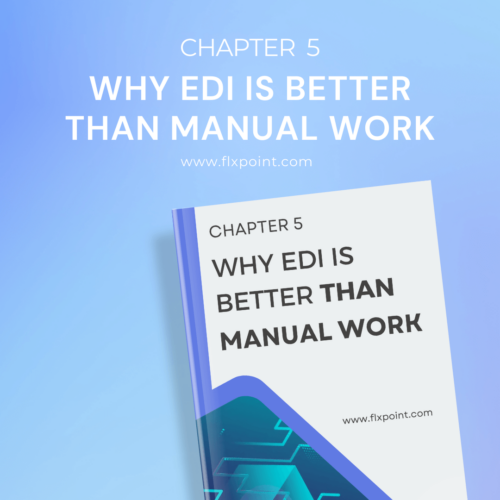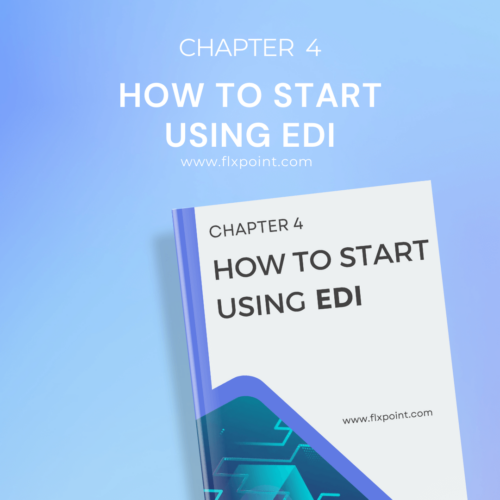Chapter 5 Why EDI is Better Than Manual Work
Compare EDI to manual processes. Learn how EDI reduces human error, boosts productivity, and offers scalability that manual work can't match.

Chapter 5: Why EDI is Better Than Manual Work
Manual processes in ecommerce involve paper documents, emails, and repetitive data entry. These tasks are time-consuming and prone to errors. Miscommunications and delays in manual workflows can lead to missed orders, incorrect inventory levels, and unhappy customers. EDI (Electronic Data Interchange) replaces these outdated methods with automated, accurate, and faster processes. It ensures smooth communication between businesses and their partners, reducing inefficiencies and costs.
In today’s fast-paced ecommerce environment, automation is essential for staying competitive. EDI not only saves time but also helps businesses scale operations, improve accuracy, and deliver better customer experiences.
Saves Money by Reducing Paperwork and Errors
Switching from manual processes to EDI (Electronic Data Interchange) significantly reduces costs and improves efficiency for businesses. EDI eliminates the need for paper-based workflows, lowering expenses related to printing, storage, and handling physical documents. Beyond cost savings, it minimizes human errors, which are common in manual data entry. Errors in orders, invoices, or inventory updates can lead to delays, dissatisfied customers, and financial losses. By automating data exchanges, EDI ensures accuracy and speeds up processes, resulting in fewer mistakes. Additionally, EDI reduces overall operational costs, offering a scalable, long-term solution that supports business growth without increasing overhead.
Eliminating Manual Paperwork
How EDI Replaces Paper-based Processes with Digital Transactions.
- Automates transactions such as orders, invoices, and shipping updates.
- Eliminates the need for printing and mailing physical documents.
- Speeds up communication by delivering data instantly between systems.
Cost Savings on Printing, Storage, and Physical Document Handling.
- No expenses for paper, ink, or mailing supplies.
- Reduces the need for physical storage like filing cabinets.
- Avoids shipping and courier costs for document delivery.
Minimizing Human Errors
Common Mistakes in Manual Data Entry and their Business Impact.
- Miskeyed data, such as incorrect quantities or prices, can disrupt orders.
- Missing or duplicated entries lead to inventory inaccuracies.
- Errors result in delays, higher returns, and unhappy customers.
How EDI Ensures Accuracy in Orders, Invoices, and Inventory Updates.
- Automates data exchange, reducing human intervention.
- Standardizes formats, minimizing discrepancies across systems.
- Real-time updates ensure inventory and order details are always correct.
Reducing Operational Costs
Long-term Financial Benefits of Adopting EDI Over Manual Workflows.
- Lowers labor costs by reducing repetitive administrative tasks.
- Eliminates expenses associated with fixing mistakes.
- Scales efficiently as the business grows, avoiding additional overhead.
Helps Your Business Grow Without Needing More Staff
EDI (Electronic Data Interchange) empowers businesses to scale efficiently without adding to overhead costs. By automating repetitive tasks and streamlining operations, it allows companies to handle larger volumes of transactions without requiring extra staff. This approach not only saves time and money but also enhances overall productivity, making EDI an essential tool for sustainable growth.
Scaling Without Increasing Overheads
How EDI Supports Increased Transaction Volumes Without Additional Resources.
EDI is designed to process high transaction volumes seamlessly. Whether it’s managing orders, updating inventory, or generating invoices, EDI handles these tasks automatically. This eliminates the need to hire more staff to keep up with growing demands, especially during peak business periods.
Examples of Automating Repetitive Tasks are Order Processing and Inventory Updates.
Tasks like order processing, inventory tracking, and shipping updates are often repetitive and time-consuming. EDI automates these processes, reducing the likelihood of errors and ensuring operations run smoothly. For example, instead of manually entering order details, EDI directly transmits data between systems, freeing up valuable resources.
Freeing Up Employee Time
Redirecting Staff Focus from Administrative Tasks to Strategic Initiatives.
With EDI taking over administrative tasks, employees can shift their attention to more strategic activities. These might include improving customer experiences, developing marketing strategies, or exploring new growth opportunities. By removing the burden of routine tasks, EDI empowers teams to work on initiatives that drive the business forward.
How this Improves Productivity and Supports Business Growth.
Automation reduces the risk of delays and errors, allowing businesses to maintain better workflow consistency. Employees spend less time double-checking data or fixing mistakes, which directly enhances their efficiency and satisfaction.
Better Allocation of Resources
Reinvesting Saved Costs and Time
The cost savings from reducing manual labor can be reinvested into other areas. Businesses can expand their product range, improve logistics, or enter untapped markets. EDI makes it possible to allocate resources toward initiatives that promote long-term growth.
Supporting Business Expansion
By automating backend processes, EDI lays a strong foundation for growth. Whether a business plans to scale locally or internationally, EDI ensures operations can handle increased complexity without additional strain.
Makes Communication with Suppliers and Partners Faster
Effective communication is essential for running a successful business, especially in ecommerce. EDI (Electronic Data Interchange) transforms how businesses interact with suppliers and partners by making communication faster, more accurate, and more efficient.
Instant Data Exchange
How EDI Enables Real-time Communication of Orders, Inventory, and Shipping Updates.
EDI facilitates real-time sharing of critical data, such as orders, inventory levels, and shipping updates. Instead of relying on emails or phone calls that may take hours or days to process, EDI transmits information instantly between systems. This ensures that suppliers receive accurate orders without delays and that customers receive updates promptly.
The Impact of Faster Communication on Customer Satisfaction.
Faster communication ensures better service. For example, real-time inventory updates help prevent overselling, and quick order confirmations improve customer trust. When shipping updates are timely, customers stay informed, leading to higher satisfaction and fewer service inquiries.
Strengthening Supply Chain Relationships
Improving Collaboration with Suppliers and Partners through Efficient Processes.
EDI fosters collaboration by streamlining how businesses interact. Automated processes like purchase order generation and delivery notifications reduce the need for manual follow-ups. Partners appreciate the efficiency, and relationships become more collaborative.
Reducing Delays and Ensuring Smooth Order Fulfillment.
Manual communication methods can lead to delays, errors, or miscommunications, disrupting the supply chain. With EDI, order data flows seamlessly, reducing back-and-forth exchanges and ensuring timely fulfillment. Suppliers can process requests quickly, minimizing bottlenecks.
Keeping Up with Market Demands
How Fast Communication Enables Quick Responses to Inventory and Market Changes.
The ecommerce landscape is dynamic, with customer demands and market trends shifting rapidly. EDI enables businesses to stay agile by facilitating immediate responses. For instance, real-time inventory monitoring helps businesses restock popular items before running out, while fast communication with suppliers allows adjustments to orders based on sales trends.
Fast communication also supports flash sales or seasonal promotions, ensuring that supply meets demand during high-traffic periods. This responsiveness gives businesses a competitive edge and keeps operations aligned with market expectations.
Conclusion
EDI offers significant advantages over manual processes. By automating tasks like order processing and invoicing, EDI reduces errors and saves time and money. This efficiency boost allows businesses to grow faster and better serve customers. Moreover, EDI facilitates seamless communication across the supply chain, strengthening relationships with suppliers and partners. By embracing EDI, businesses can streamline operations, improve accuracy, and achieve sustainable success in today’s competitive market. Moving away from manual work is important for efficiency and scalability in the modern business world.
Guide Chapters
- Chapter 1: What is EDI?
- Chapter 2: How EDI Helps Ecommerce Businesses
- Chapter 3: Everyday Uses of EDI in Ecommerce
- Chapter 4: How to Start Using EDI
- Chapter 5: Why EDI is Better Than Manual Work
- Chapter 6: EDI vs. APIs: What's the Difference?
- Chapter 7: The Future of EDI in Ecommerce
- Chapter 8: Your First Steps with EDI
- Chapter 9: EDI is the Future of Ecommerce
- Chapter 10: Quick Glossary of EDI terms
- Chapter 11: Checklist to Prepare for EDI Setup
All Chapters in This Guide

Start with the essentials. This chapter breaks down what EDI is, how it works, and why it’s a critical tool for modern ecommerce businesses. We simplify the technical jargon so you can clearly understand how EDI automates the exchange of business documents with your suppliers, warehouses, and trading partners.

Explore the powerful benefits EDI brings to your ecommerce operations. From faster communication and fewer errors to cost savings and improved accuracy, this chapter shows how EDI makes your business leaner, smarter, and more competitive.

See how EDI shows up in real day-to-day workflows. This chapter highlights common applications like order placement, shipping confirmations, inventory updates, and invoicing—so you can understand the practical ways EDI supports smooth operations.

Ready to get started? This chapter walks you through the process of adopting EDI, including evaluating your current tech stack, selecting the right partners, and integrating EDI into your existing systems. No technical background required—we make it approachable.

If you're still relying on spreadsheets, emails, or manual uploads to exchange data, this chapter is a game-changer. Learn how EDI eliminates human error, speeds up workflows, and allows your business to scale without adding more headcount.

Wondering when to use EDI or APIs? We break down the differences between these two powerful tools, when each makes the most sense, and how they can work together in a well-rounded ecommerce tech stack.

EDI is evolving rapidly. In this chapter, we explore upcoming innovations—like machine learning, tighter integrations with fulfillment partners, and greater automation. Discover how to stay ahead of the curve and be ready for what’s next.

It’s time to take action. This chapter provides a hands-on guide to assessing your business readiness, aligning with trading partners, and identifying the tools you need to implement EDI smoothly and successfully.

This isn’t just a short-term solution—it’s a long-term strategy. Learn why businesses adopting EDI today are better positioned to grow, adapt to change, and lead in a digitally connected ecommerce world.

EDI doesn’t have to be intimidating. We’ve created a glossary of key terms and acronyms to make the language of EDI more accessible, so you can communicate confidently with partners and providers.

Make sure you’re truly ready. This checklist walks through everything you’ll need to set up EDI the right way—from choosing the right platform to aligning your workflows and evaluating technical requirements. Consider this your pre-launch playbook.
Kenneth Cole's Smart Savings With Shopify EDI Connections
"They had never used Flxpoint before. But working with [the Flxpoint] team, they learned it and we're about to onboard our newest footwear partner, and you know that's big business for us.”
Mitul PatelKenneth Cole


How Flxpoint Helped Rifle Supply Automate & Grow
“I went line by line… whatever the inventory number was and cost value was, I calculated it and was blown away by how much that was worth— $300 million worth of product that I added to our web store.”
Chris MekdaraRifle Supply


The Ecommerce Automation Behind Screen Skinz
"Automation is the key to maximizing your volume. [Flxpoint] comes right into our flow — everything's automated. We want it to be quick and efficient. So that's what we love about Flxpoint."
Shaun Brown & Clay CanningScreenSkinz


How Inhaven Transformed Vendor Management with Flxpoint
"We ended up switching to Flxpoint, and it has been a much smoother process. Where it took us six months to get onboarded with the other company, we were up and running in a week or two with Flxpoint."
Ashley ChingInhaven


How Black Patch Performance Scaled Smarter with Flxpoint
"The only way to actually scale was to go through Flxpoint… You can’t even come close to hiring someone to do what Flxpoint does for the price."
Jonathan WilliamsBlack Patch Performance


